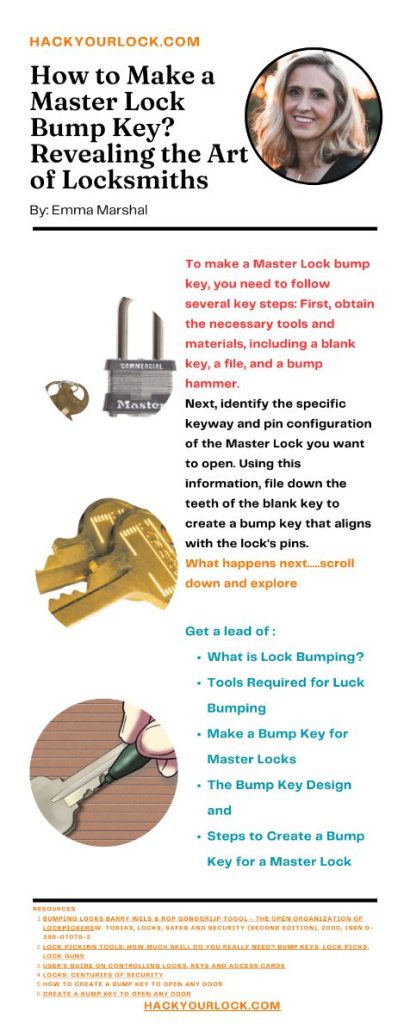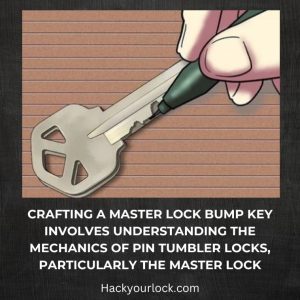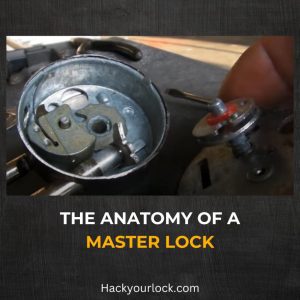Locks and keys have been a fundamental part of human security for centuries, protecting our homes, possessions, and businesses.
However, as with any security measure, some seek to understand and, in some cases, manipulate it.
One such method is the creation of a bump key, a tool that can open a Master Lock with remarkable ease.
In this article, we will explore the art and technique of how to make a Master Lock bump key, shedding light on the mechanisms that make it possible and discussing the ethical and legal considerations surrounding its use.

Whether you’re a locksmith looking to expand your knowledge or a concerned citizen interested in understanding lock security, this article will provide valuable insights into this intriguing facet of security technology.
Contents
How to Make a Master Lock Bump Key

Crafting a Master Lock bump key involves understanding the mechanics of pin tumbler locks, particularly the Master Lock, and using this knowledge responsibly.
To make a Master Lock bump key, you need to follow several key steps: First, obtain the necessary tools and materials, including a blank key, a file, and a bump hammer.
Next, identify the specific keyway and pin configuration of the Master Lock you want to open. Using this information, file down the teeth of the blank key to create a bump key that aligns with the lock’s pins.
Fine-tune the key by testing it in the lock, making adjustments as needed. Once you have a properly crafted bump key, insert it into the lock and apply controlled force with the bump hammer while simultaneously turning the key. This should cause the pins to jump, allowing the lock to turn and open.
This is just a short representation of how to make a master lock bump key.
What is Lock Bumping?
Lock bumping is a lock manipulation technique used to open locks, such as door locks, by exploiting their internal mechanisms.
It involves inserting a specially designed bump key into the lock and applying controlled force with a bumping tool, causing the lock’s pins to jump and momentarily separate, allowing the lock to turn and open.
This technique is often used by locksmiths to quickly and non-destructively gain access to locks when authorized to do so.
The history of lock bumping dates back to the early 20th century, when it was first discovered and utilized by locksmiths as a legitimate means of lock opening.
However, over time, the knowledge of bumping techniques spread beyond the locksmithing community, becoming a concern for security professionals and law enforcement.
As a result, bumping techniques have evolved, with more refined tools and methods developed for both lawful and illicit purposes.
Today, the ease of access to information on the internet has made lock bumping knowledge readily available, raising legal and ethical concerns regarding its use.
While locksmiths continue to use bumping as a legitimate skill, its potential for misuse has led to legal restrictions and ethical considerations surrounding its dissemination and application, emphasizing the importance of responsible knowledge sharing and ethical locksmithing practices.
How to make a master lock bump key is the major query that new learners seek answers to. You can find some related details below.
Tools Required for Luck Bumping
To effectively bump a lock, it’s crucial to understand the essential tools needed and how to acquire them.
First and foremost, you require two primary tools: a bump key tailored to fit the specific lock you intend to open and a bump hammer for the technique’s successful execution.
1. The Bump Key

Fundamentally, a bump key is no ordinary key; it undergoes a distinct transformation where all its “cuts” reach their maximum depth potential.
These cuts are typically denoted by numbers on a scale from 0 to 9. A 9 indicates the deepest cut, while 0 represents the shallowest. To simplify matters, a bump key is commonly associated with a cut pattern of 99999, earning it the nickname “999 key.”
Although the teeth of a bump key may seem unusually short, they play a pivotal role – they establish contact with the lock’s pins when inserted into the keyway.
This interaction forms the cornerstone of the bumping technique’s effectiveness.
It’s worth emphasizing that bump keys are not universally interchangeable; each one corresponds to a specific keyway. In other words, a bump key designed for a Schlage lock won’t be compatible with a Kwikset lock.
Acquiring bump keys is conveniently achievable through numerous online lock picking stores. Alternatively, if you prefer a hands-on approach, you can fashion your own by skillfully filing down the bitting of a standard key using a triangle file.
2. Hammer

In addition to the bump key, another essential tool in your arsenal is the bump hammer, a compact mallet crafted specifically for tapping the key’s head and initiating the bumping process within the lock.
While specialized bump hammers are easily accessible through online sources, there’s no imperative need for a high-end, professional-grade tool.
Similar results can be attained with common household items such as a rubber mallet, the handle of a screwdriver, or even a wooden block. In situations where resources are limited, improvisation is possible by wrapping your hand in cloth and utilizing your palm to deliver the necessary impact to the key.
The bump key and hammer are a starting point for how to make a master lock bump key.
How a Pin Tumbler Lock Works
Understanding how pin tumbler locks work is essential before delving into lock bumping and crafting a Master key, as it lays the foundation for comprehending how bump keys manipulate the pins to open the lock.
Parts of Pin Tumbler Lock
There are six components of a pin tumbler lock that you need to be aware of in relation to lock bumping.

Six Parts of a Pin Tumbler Lock are as follows:
- Plug: The part of the lock you turn with the key.
- Key Pins: Small pins that touch the key.
- Driver Pins: Pins above the key pins.
- Springs: Push the pins towards the plug.
- Shear Line: Gap between plug and housing.
- Housing Cylinder: The outer part of the lock that contains the other functional parts of the lock.
How Pin Tumblers Work
When you insert the correct key into a pin tumbler lock, the key pins align with the shear line, creating a gap. This allows the plug to rotate freely, unlocking the lock. Incorrect keys won’t align the pins, keeping the shear line blocked and preventing the lock from turning.
Now that we are aware of this mechanism let’s go and finally discover how to make a Master Lock bump key.
Make a Bump Key for Master Locks
To make a bump key for the master lock, you must understand the anatomy of a master lock, the bump key design, and bumping techniques. Let’s go through them now.
The Anatomy of a Master Lock

Exploring the inner workings of a Master Lock reveals a fascinating combination of mechanisms designed to secure your belongings.
At the heart of this lock is a series of precisely crafted pins and a keyway, which play pivotal roles in its operation. The keyway is the unique channel or groove into which the key is inserted, providing access to the lock’s internals.
Within this keyway reside the pins, specifically the key pins and driver pins, arranged in a stack. The key pins are directly touched by the key upon insertion, while the driver pins rest above them. Springs exert pressure on the pins, keeping them firmly in place.
This configuration sets the stage for how key bumping exploits the lock’s mechanisms. When a correctly crafted bump key is inserted into the keyway and subjected to controlled force, it momentarily lifts the driver pins above the shear line, allowing the plug to rotate freely and unlock the Master Lock.
This ingenious manipulation of pin positions demonstrates the vulnerability of pin tumbler locks to bumping techniques. It underscores the importance of understanding their inner workings for both locksmithing enthusiasts and those concerned with security.
The Bump Key Design
Creating an effective bump key involves several crucial design considerations. First and foremost, the key must match the specific lock’s keyway, ensuring a proper fit.
Additionally, the key should have cuts adjusted to maximum depths, typically following the 99999 pattern. These deep cuts enable the key to engage with the lock’s pins effectively.
Lastly, the overall key design should be precise to minimize the risk of damage to both the lock and the key itself during the bumping process.
Steps to Create a Bump Key for a Master Lock
Here are the steps to make a Master Lock Bump Key:
1. Select a Blank Key
Start by acquiring a blank key that closely matches the specific keyway of the Master Lock you intend to manipulate. This key will serve as the foundation for your bump key.
2. Examine the Keyway
Carefully examine the keyway of the Master Lock to identify its unique shape and features. Understanding the keyway’s nuances is crucial for accurately replicating it on your bump key.
3. File the Key Cuts
Using a fine-cut file, begin shaping the key’s cuts to their maximum depths. Typically, the bump key follows the 99999 pattern, which means you’ll need to create cuts as deep as possible on the key.
This step demands precision to ensure the key aligns with the lock’s pin configuration.
4. Check Key Fit
After filing the key to match the desired cut pattern, insert it into the lock’s keyway. This is a critical step to test the key’s compatibility and functionality.
Ensure that the key slides smoothly into the lock and reaches the correct depth.
5. Fine-Tuning
If the key doesn’t consistently open the lock, you may need to make slight adjustments to its cuts.
Carefully file down any high points or irregularities to refine the key’s design. The goal is to achieve a bump key that operates seamlessly.
6. Test and Refine
Continuously test the bump key in the lock to gauge its effectiveness. Fine-tune the key as needed by making small, precise adjustments until it reliably opens the lock.
This iterative process ensures that your bump key is optimized for successful lock manipulation while minimizing potential damage to the lock or key.
By following these steps with precision and patience, you can make a Master Lock bump key, a valuable skill for locksmithing enthusiasts. Remember always to use this knowledge responsibly and in accordance with applicable laws and ethical considerations.
Fine-Tuning the Key for Optimal Results
Create A Bump Key To Open Any Door to fine-tune the master lock bump key for optimal results. It is essential to conduct testing and adjustments. Insert the key into the lock and practice the bumping technique, observing how the lock responds.
If the key doesn’t consistently open the lock, make slight adjustments to the key’s cuts using the file until you achieve a more reliable and effective bumping process.
Fine-tuning ensures that the bump key functions seamlessly and efficiently, increasing the chances of successful lock manipulation while minimizing potential damage to the lock or key.
Tips for Successful Bumping
How To Create A Bump Key To Open Any Door. Follow tips for successful bumping.
- Choose the Right Bump Key: Ensure it matches the lock’s keyway and cut pattern.
- Apply Controlled Force: Use a bump hammer gently for impact.
- Practice: Hone your technique for consistent results.
- Maintain the Keyway: Keep it clean for smooth key insertion.
Troubleshooting
| Common Issues | Solutions and Tips |
| Inconsistent Results | Adjust the bump key if needed. |
| Key Stuck | Gently jiggle to release. |
| Lock Damage | Use bumping responsibly. |
| Legal and Ethical Considerations | Always abide by the law and ethics. |
Responsible Knowledge Sharing
Responsible bump key knowledge sharing necessitates ethical considerations, emphasizing the importance of responsible use and legal compliance. Misuse can lead to severe legal consequences, highlighting the need for ethical education and compliance with laws in lock security practices.
Alternatives to Bump Keys
| Alternatives to Bump Keys | Advantages of Each Method | Disadvantages of Each Method | Legal and Ethical Considerations for Alternative Methods |
| Lock Picking | Precise and versatile. | Requires skill and may damage the lock. | Legal when performed by authorized individuals; ethical conduct is essential. |
| Lock Bypassing | Quick and non-destructive. | Limited applicability. | Legal if used in legitimate situations; ethical usage is paramount. |
| Locksmith Services | Professional expertise. | It may involve cost and waiting time. | Legal when performed by licensed locksmiths; ethical standards apply. |
| Lock Replacement | Guaranteed security. | Expensive and time-consuming. | Legal when authorized or in case of lock malfunction; ethical use is expected. |
Conclusion
Mastering the craft of how to make a Master Lock bump key is a skill that, when wielded responsibly, can enhance personal security and locksmithing prowess.
However, it is crucial to emphasize that this knowledge should be handled with the utmost care and ethical consideration.
By understanding the intricacies of lock mechanisms, the process of crafting a bump key, and the importance of responsible knowledge sharing, readers can empower themselves while ensuring that the art of the “Master Lock bump key” remains a force for good and a symbol of locksmithing integrity.
FAQ’s
Is it legal to create and use a Master Lock bump key?
Crafting a bump key for personal use or locksmithing purposes within legal boundaries is typically permissible. However, using a bump key for unauthorized access or any unlawful activities is illegal and unethical. Always adhere to local laws and ethical guidelines when dealing with lock manipulation techniques.
Can I use a bump key to open any Master Lock?
No, bump keys are not universal. They must match the specific keyway of the lock you intend to open. Each type of Master Lock may have a different keyway design, requiring a bump key tailored to that lock’s specifications.
Are there alternative methods to open a Master Lock without a bump key?
Yes, there are various alternative methods, including lock picking, lock bypassing, locksmith services, and lock replacement. These methods each have their advantages and disadvantages, and the choice depends on the situation, skills, and ethical considerations.
Resources
- Bumping Locks Barry Wels & Rop Gonggrijp Toool – The Open Organization Of LockpickersW. Tobias, Locks, Safes And Security (Second Edition), 2000, Isbn 0-398-07079-2
- Lock Picking Tools: How Much Skill Do You Really Need? Bump Keys, Lock Picks, Lock Guns
- User’s Guide On Controlling Locks, Keys And Access Cards
- Locks: Centuries Of Security
- How To Create A Bump Key To Open Any Door
- Create A Bump Key To Open Any Door
- Master Locksmithing : An Expert’s Guide to Master Keying, Intruder Alarms, Access Control Systems, High-Security Locks… By Bill Phillips · 2007
